Lost Cities – An Expedition for Two

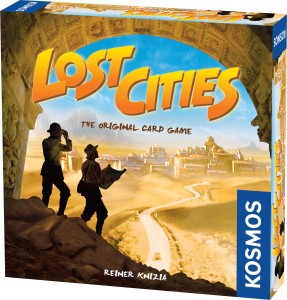
Lost Cities – an expedition for two players
Lost Cities is the first Euro card game my husband and I ever owned. My husband picked it up at a thrift store in San Diego and put it in our game cabinet, where I’m ashamed to say it remained until after we moved to South Carolina. It wasn’t until we played it at another gamer’s house that we realized we had a treasure, undiscovered in our game cabinet. I’m proud to say that now the cards are well-worn due to the number of times we’ve played it since then. Recently teaching it to a couple who happened in our store last week helped put it the front of my mind when I began planning my two-player game reviews for Valentine’s Day. So, on to the treasure that is Lost Cities.
In Lost Cities, your goal is to make the most profitable expeditions – determined after 3 rounds of play. Expeditions are represented by columns of cards in 5 colored suits (red, yellow, green, blue and white). Each suit includes 3 Investment cards and the numbers 2 thru 10. As soon as you start an expedition (play the first card to one of the five columns), you’re immediately in the hole 20 points. The only way to make that expedition profitable is to play enough cards in that column to add up to more than 20 points. Any Investment cards you play will double, triple or quadruple the points you score in that column, whether negative or positive. And if you play 8 or more cards in a single column, you’ll earn a 20-point bonus. The trick is, you have to play your cards in ascending order after any Investment cards.
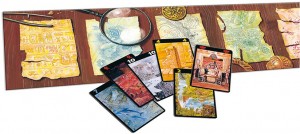
Lost Cities board and sample cards
Players begin with a hand of 8 cards. On your turn, you must play or discard one card face up, then draw a card. There are five discard piles, one for each color suit. You can draw either the top card of the draw pile or the top card from one of the discard piles. When the draw pile is exhausted the game ends immediately. If you still have cards you want to play and the deck is running low, you might want to draw from a discard pile – even if it’s a card you don’t need or can’t use – just to prolong the game and get your cards played.
Lost Cities is a game of hard choices. Do you wait until you have enough cards to conduct a profitable expedition before you begin it and risk not having enough time to play all of them? Do you start an expedition now and hope you draw the cards you need to add up to 20 plus? And what do you do when you have the 5, 8 and 10 of the same suit? That’s a profitable expedition right there, but there are still 3 Investment cards, a 2, 3, 4, 6, 7 and 9 out there. Do you wait for them before beginning the expedition? If you play your 5 now, you won’t be able to play the 2, 3, 4 or any Investment cards you draw later. No chance of earning that 8-cards-in-a-column bonus then. I’m telling you, the choices are tough.
There’s a lot of strategy, flavored with risk-taking in Lost Cities. You can see exactly what your fellow player has played, but you have no idea what he’s holding. While you can take and use his discards, he can take and use yours, too! It’s a game of give and take and loads of fun. Now for a history lesson.
Designed by Reiner Knizia, Lost Cities was first published in 1999 and quickly won several awards:
- 1999 Fairplay À la carte Winner
- 1999 Meeples’ Choice Award
- 2000 International Gamers Awards – General Strategy; Two-players
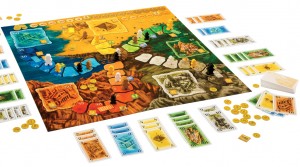
Lost Cities: The Board Game
In 2008, two board games were spun off Lost Cities: Lost Cities: The Board Game, published by Rio Grande Games here in the U.S. (recently republished by Thames & Kosmos) and Keltis, published by Kosmos in Germany. Lost Cities: The Board Game features the same archaeological look, theme and feel as Lost Cities, supports 2 to 4 players and adds a few new twists to the game with card play still always in ascending order.
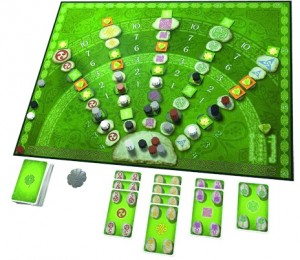
Keltis
Keltis, however, has a bright green, Irish Celtic theme along with its new twists, plus the added ability to play cards in either ascending or descending order – you choose for each expedition. There are a few other minor differences, too.
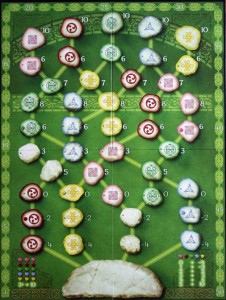
Keltis: New Paths, New Ways board
Keltis spun off an expansion board with mind-boggling twists and turns – Keltis: Neue Wege, Neue Ziele (New Paths, New Ways); the card game Keltis: Das Kartenspiel; and the travel game Keltis: Mitbringspiel (Bring-Along, aka Keltis: Stones) in 2009. Another board game featuring a spiral path – Keltis: Das Orakel (The Oracle) and the dice game Keltis: Würfelspiel followed in 2012. Keltis has achieved honors of its own: winning the coveted Spiel des Jahres award in 2008 and nominated for numerous other awards as well. Both Lost Cities and several of the Keltis games are available on iOS. Of course, they’re more fun to play in person with other players.
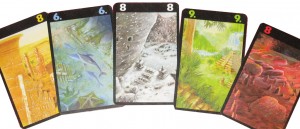
Lost Cities sample cards
Lost Cities’ components are top-notch. The cards are beautifully illustrated, large, easy to read and have a nice feel to them. The coordinatingly illustrated board provides designated spots for the discard piles and guides placement of each player’s expedition cards. The box recently got a cover art makeover and is the usual Kosmos 2-Player Game size. Lost Cities is easily my favorite game from that series. While so many games in that series are high-conflict, Lost Cities is definitely not. It is competitive, though, and you do have to pay attention to what your opponent is doing, but you don’t have to take him out.
Interestingly, only the original Lost Cities was designed for just two players. All of its spin-offs support 2 to 4 players. Lost Cities is one of the select two-player games I recommend most often. (With two copies of Lost Cities, you can play a partnership variant that is extremely fun and exciting, particularly if you love partnership cards.) Play time is about 30 minutes. If you’re short on time, you can play just one round in about 10 minutes. The rules say to add the scores of three rounds to determine the winner. Love it, highly recommend it. What else can I say?
Copyright © 2016 by Tina G. McDuffie. All rights reserved.
Photo rights retained by their respective copyright holders.

Pingback: It Takes Two: 7 Games We Love to Play as a Couple - The Glass Meeple
Pingback: Keltis - An Emerald Green Game for St. Paddy's Day Game - The Glass Meeple
Pingback: Keltis - An Emerald Green Game for St. Paddy's Day - The Glass Meeple
Pingback: The 12 Game Gifts of Christmas: 4th Day - The Glass Meeple
Pingback: 24 Days of Gaming Stocking Stuffers - Part 2 - The Glass Meeple